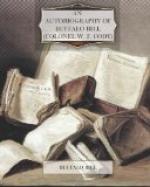I remained with General Miles until the final surrender of the North American Indians to the United States Government after three hundred years of warfare.
This surrender was made to Miles, then lieutenant-general of the army, and it was eminently fitting that a man who had so ably conducted the fight of the white race against them and had dealt with them so justly and honorably should have received their surrender.
With that event ended one of the most picturesque phases of Western life—Indian fighting. It was with that that I was identified from my youth to my middle age, and in the time I spent on the Plains, Indian warfare reached its greatest severity and its highest development.
CHAPTER XIII
In the preceding chapters I have sketched briefly some of the most interesting of my adventures on the Plains. It has been necessary to omit much that I would like to have told. For twenty years my life was one of almost continuous excitement, and to tell the whole story would require many volumes.
It was because of my great interest in the West, and my belief that its development would be assisted by the interest I could awaken in others, that I decided to bring the West to the East through the medium of the Wild West Show. How greatly I was to succeed in this venture I had no idea when it first occurred to me. As I have told you, I had already appeared in a small Western show, and was the first man to bring Indians to the East and exhibit them. But the theater was too small to give any real impression of what Western life was like. Only in an arena where horses could be ridden at full gallop, where lassos could be thrown, and pistols and guns fired without frightening the audience half to death, could such a thing be attempted.
After getting together a remarkable collection of Indians, cowboys, Indian ponies, stage-coach drivers, and other typical denizens of my own country under canvas I found myself almost immediately prosperous.
We showed in the principal cities of the country, and everywhere the novelty of the exhibition drew great crowds. As owner and principal actor in the enterprise I met the leading citizens of the United States socially, and never lost an opportunity to “talk up” the Western country, which I believed to have a wonderful future. I worked hard on the program of the entertainment, taking care to make it realistic in every detail. The wigwam village, the Indian war-dance, the chant of the Great Spirit as it was sung on the Plains, the rise and fall of the famous tribes, were all pictured accurately.
It was not an easy thing to do. Sometimes I had to send men on journeys of more than a hundred miles to get the right kind of war-bonnets, or to make correct copies of the tepees peculiar to a particular tribe. It was my effort, in depicting the West, to depict it as it was. I was much gratified in after years to find that scientists who had carefully studied the Indians, their traditions and habits, gave me credit for making very valuable contributions to the sum of human knowledge of the American native.




